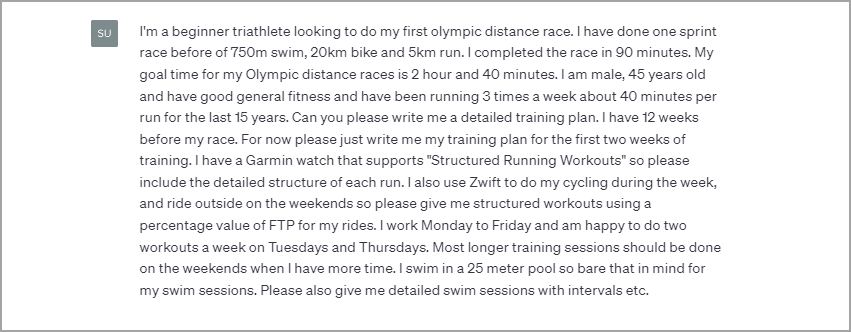Hey coaches! In January I wrote about AI potentially replacing endurance coaches in my post “Will AI Replace Coaches?”. In that post I talked about how AI had been around a while but honestly wasn’t very useful, but was starting to get really good at lots of things. I wasn’t sure whether it would replace coaches or not.
Well, with the rapid advancements in AI in a few short months since then, my thoughts have evolved.
Now the question isn’t whether AI will replace coaches but rather “Which coaches will AI replace?”
Now, I more urgently and strongly believe that coaches who don’t start adapting their offerings will be replaced as new AI-based coaching platforms emerge. But don't panic just yet, in this blog, we'll chat in more detail about how coaches can adapt and grow in this changing landscape. We'll discuss four key points that will help coaches harness the power of AI while providing unique value to their clients that AI may never be able to replicate.
You can continue to read the post or listen to the audio version on our podcast or the video version here
To emphasize my point about how capable AI has now become, I am also worried about AI replacing software developers. As a software developer of 20 years I’ve always thought that the complex nature of building software would be impossible for AI to replicate. What I’ve seen over the last few weeks, has changed my opinion on that. The saving grace for me that as a small business owner I’m much less likely to lose my job because of AI. I discuss this advantage in the post as well.
In this updated blog post, we'll delve into the following topics:
- AI's new found capabilities in analyzing and prescribing training, and how it will lead to more coaching platforms targeting athletes directly, side stepping coaching businesses.
- The advantage small business owners, like endurance coaches, have over bigger businesses and their employees when it comes to leveraging AI.
- Why low-cost one-on-one coaches will likely be the first to be replaced by AI, and the importance of focusing on higher value price points.
- The power of accountability and human connection that AI cannot yet replicate, which coaches can use to differentiate themselves.
- The role of community building and fostering a fun, supportive environment for athletes to ensure the continued relevance of coaching practices.
By embracing AI and focusing on the unique value they bring, endurance coaches can continue to thrive in this ever-changing world. So, let's dive into these exciting yet worrying developments and explore the future of endurance coaching in the age of AI!
AI Can Now Easily Analyze and Prescribe Training
Generalized AI systems, like ChatGPT-4, are now capable of analyzing training data and prescribing workouts with remarkable precision. These AI systems can monitor athletes' progress, detect patterns, and make adjustments to their training plans based on the available data. While these advancements will undoubtedly streamline many coaching processes, it's important to remember that AI's reach currently stops at data-driven tasks, leaving room for coaches to focus on other aspects of their business. It’s now just a matter of time until more and more coaching platforms get launched ignoring coaches and targeting athletes directly. Even before AI most coaching platforms have had their feet in both camps, offering software directly to athletes but also to coaches. The better AI becomes at planning and analyzing training data the more the platforms will target athletes directly.
Training Tilt is still the only coaching platform that focuses 100% on coaches. We don’t offer any services directly to athletes and we will continue to help coaches as best we can navigate the changing coaching environment.
Here is just a very quick example from using ChatGPT which is based on GPT-4 which is an Language Learning Model (LLM). Bare in mind this model is a generic model so what you see here could be improved greatly by building an endurance coaching platfrom over top of the model and training it more on specific coaching principles. ChatGPT is merely the chat interface to interact with the model. Even in this basic form the results are very impressive.
Additionally, results can easily be improved by creating a longer more detailed initial prompt. I literally just took 3 minutes to do this.
First I entered a simple prompt to give the AI some context and a fitness background so it had some details to work with. If I wanted to I could have made this much longer and more detailed to get finer results.
and here is the first week of prescribed training. ChatGPT is all text based but if I was to build a platform over top of this AI would be able to format this data in a way that I needed and then automatically generate the individual workouts including the structured workouts ready to sync with Training Platforms like Zwift and Garmin.
Now you could easily find flaws in this plan if you were looking for them, but remember this is a very basic prompt we are using, coaching platforms building on top of this AI would be using much more nuanced prompts with the ability to add in specific training principles and information that would allow the AI model to fine tune the plan even further. Additionally after generating the plan it is easy to build a feedback mechanism over top in the user interface to allow the end using to ask the AI to tweak specific workouts and even add in more specific scheduling based on the athletes preferences and even work and personal schedule.
Here's the second week of prescribed training.
You'll noitice a little glitch here where ChatGPT just stalled after Friday. This happens reasonably frequently with the ChatGPT interface because of the volume of people currently using it. Probably at this point 100's of thousands of concurrent users soon to be millions. Don't let this lull you into a false sense of security though as the back end API that will be used by software platforms won't have as many of these issues, this is more of a scaling issue of ChatGPT rather than a weakness in the AI itself.
I simply asked it to carry on where it left off.
And there you have it, AI has come a long way in just a few short months and will keep accelerating. The example form ChatGPT is raw and simple but illustrates just how powerful AI can be with just a simple prompt, even more will be possible as coaching platforms begin to build on top of it.
But let's keep a positive mindset. There is a lot more to coaching than prescribing and analyzing training. It's those things we need to focus on as coaches as I'll talk about more in the post.
Let's get bac to the post.
Small Business Owners Have an Advantage Over Employees
Small business owners like myself, and endurance coaches like you, have the unique opportunity to leverage AI to become more efficient and effective solo entrepreneurs. By integrating AI into your coaching practice, you can automate various tasks, such as analyzing training data, generating content and streamlining processes, allowing you to focus on more personalized and value-added services. The ability to adapt and take advantage of AI will be a significant differentiator for small business owners like us, setting us apart from employees in larger organizations. Employees will have less leverage than business owners because large teams of people can easily be replaced by a few high performing individuals who are the fastest at integrating AI into their daily work. Unlike employees, small business owners have the opportunity to choose to adopt AI into our workflows to save us a lot of time and give ourselves superpowers to produce 1000% more output than we ever could before. This results in being able to do more with fewer people. Businesses win, employees lose.
Inexpensive One-on-one Coaches Will be Replaced First
The first endurance coaches to be replaced by AI will likely be those offering low-cost one-on-one coaching. This is not directly due to the quality of the coaching service provided for a low price but rather the fact that clients who are attracted to these lower prices are often more price-sensitive and will readily switch to AI coaching platforms that offer similar services at a lower cost.
The more people pay, the more they value the service, and the more they are committed to the relationship.
In terms of one-on-one coaching to maintain a competitive edge, endurance coaches should focus on providing coaching at higher price points, offering personalized services that AI cannot yet replicate. Accountability, community, engagement, fun, friendship, camaraderie. All these “Human” things that AI will struggle to replicate.
The Power of Accountability
While AI can now easily replicate a coach to analyze data and provide training recommendations, it currently lacks the ability to provide the accountability and motivation that comes from having a human coach monitoring an athlete's progress. This element of one-on-one coaching is invaluable and should be a key focus for coaches who want to differentiate themselves from AI coaching platforms. By building strong relationships with their clients, coaches can provide the support and accountability needed for athletes to reach their goals. AI can “fake” this quite well now, but without a human on the other side of accountability, is there actually accountability? I think not.
Building a Community and Having Fun
Another area where AI falls short is in fostering a sense of community, camaraderie, and belonging among athletes. Coaches have the unique opportunity to create a tribe that brings people together, offering a supportive environment for athletes to grow, learn, and share experiences. By focusing on building strong communities, coaches can offer something that AI simply cannot replicate, ensuring the continued relevance of their coaching practice.
Community can be created as part of your one-one-one coaching services but can be even more powerful through more scalable coaching products and services, creating an even stronger competitive edge. You can read more about how to mix in scalable coaching products and services with your one-on-one coaching services in my post about “The Six Figure Endurance Coaching Business Framework”
Conclusion
Don’t be one of the coaches AI replaces first.
As AI continues to advance, endurance coaches will undoubtedly face challenges in maintaining the viability of their businesses. However, by embracing the power of AI, focusing on higher price points for one-on-one coaching, emphasizing accountability, and building strong communities, coaches can continue to thrive in the age of AI. The future of endurance coaching lies in the ability to adapt and provide value-added services that AI cannot yet replace.
Want to start adapting your business to build a competitive edge as AI continues to improve in leaps and bounds? I’d love for you to try Training Tilt, the only endurance coaching platform focusing on coaches. Sign up for free trial and we what’s possible.
Take our Free "Authentic" Marketing Course for Coaches
Designed for endurance sport coaches. Marketing doesn't need to be pushy. The best marketing simply creates a win-win relationship between you and your customers. Take the simple 6 part course to learn more.


















